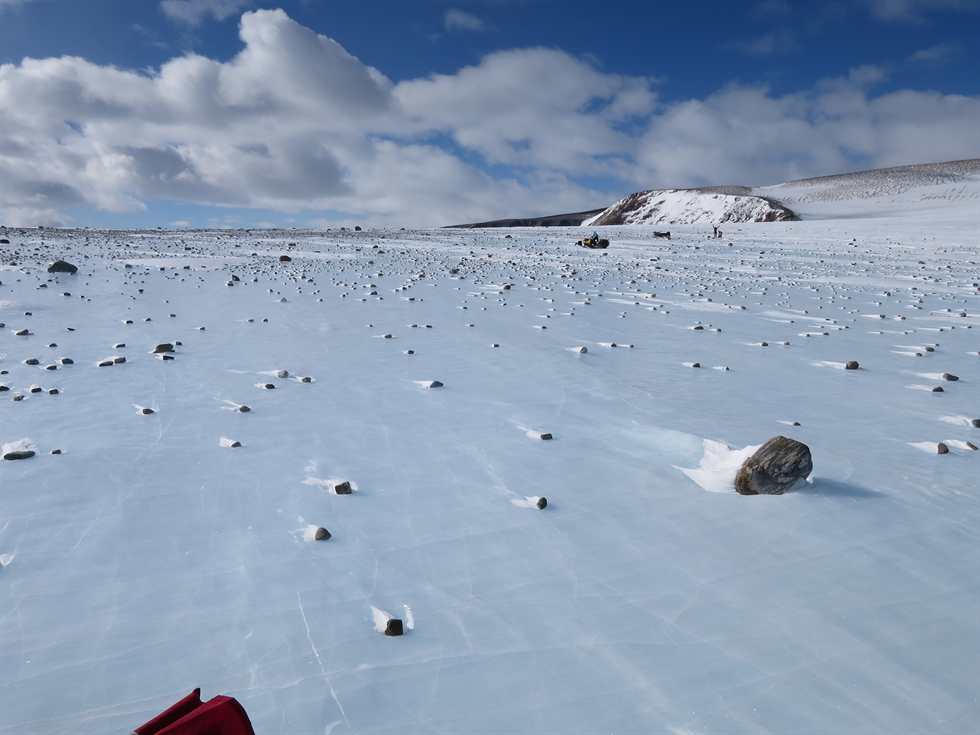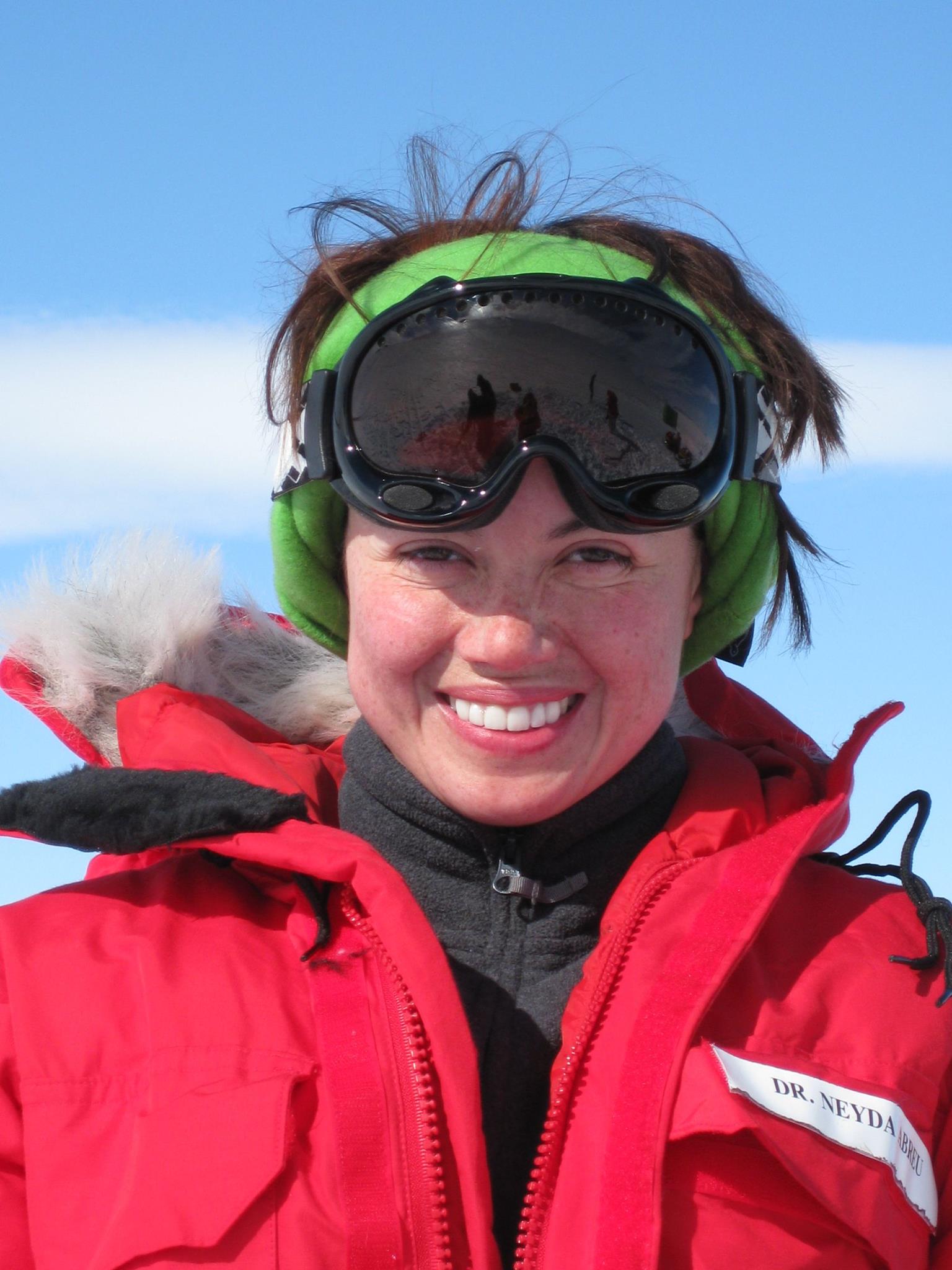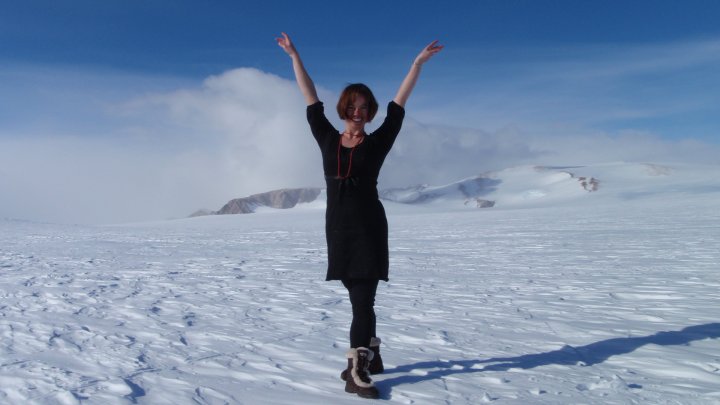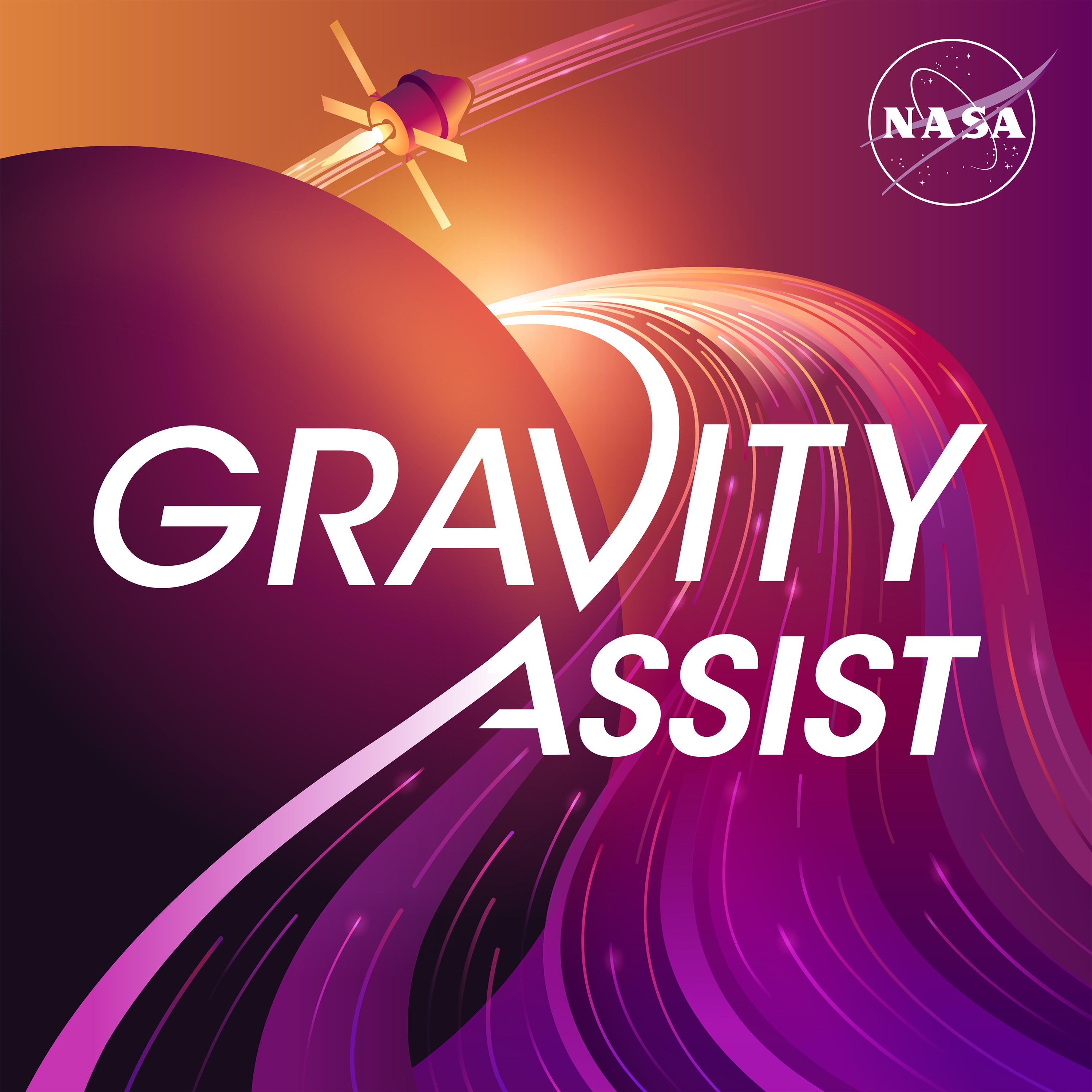
How do we know if a rock came from the Moon, Mars, or an asteroid? Planetary scientist Neyda Abreu has looked inside all kinds of meteorites to understand where they came from and what’s inside them. She also traveled to Antarctica to hunt for space rock treasure. Since she was a child in Venezuela, she has been curious about the life cycles of stars and planets. Learn about her work with meteorites and her journey to become a scientist.
Jim Green:Small pieces of the earliest rock fall on the Earth every day. How do we find them? And what can they tell us about the makeup of our planet? And perhaps how life started on Earth?
Jim Green: Hi, I’m Jim Green. And this Gravity Assist, NASA’s interplanetary talk show. We’re going to explore the inside workings of NASA and meet fascinating people who make space missions happen.
Jim Green:I’m here with Dr. Neyda Abreu. And she’s a planetary scientist, and the senior advisor for science and research at NASA’s Langley Research Center. Welcome, Neyda, to Gravity Assist.
Neyda Abreu:I’m thrilled to be here. Thank you so much for the invitation. And thank you for having me.
Jim Green: My pleasure. Now, I understand that you’ve been involved in studying meteorites, what are meteorites?
Neyda Abreu: The most simplified way to explain it is rocks from space. Now, I think it was Muriel Rukeyser, who said that the universe is made out of stories, not of atoms. And if that’s the case, then meteorites are some of the most interesting storytellers that you can imagine. They have been in the right places at the right times. And one of the things that really excited me about being able to look at these samples was the ability to piece together these stories of the solar system by understanding what had happened to these rocks.
Neyda Abreu: And they rain on us, so they make it easy on us to be able to ask those questions and to be able to see how these very small samples sometimes can tell us about very large processes, and how they can tell us about things that have happened over periods of times that are incredibly extensive.
Jim Green:Well, what originally got you interested in studying meteorites?
Neyda Abreu:So I was interested in origins of the solar system for quite a long time. I, as I said, I like stories. And this is, in some ways, the grandest story that you can probably tell.
Neyda Abreu:Well, I grew up in the Venezuelan Andes. And that’s very north of South America. And there’s some big mountains. And one of the nice things about being high up is there were some very nice telescopes. Some of the few equatorial latitude telescopes were located in my hometown. So that attracted me to going into astronomy as well. And eventually, I decided to come to the US to continue my studies. So when I was, I believe, 17, I came to Minnesota, I went to the University of Minnesota, and had a really fantastic opportunity to do my undergraduate in physics and astronomy.
Neyda Abreu:And then I realized that I wanted to have something tangible. And in some ways, being able to have this artifact, this piece of solar system history in my hands on my desk, being able to go back to the lab all the time and be able to look at these samples, sometimes I was the first person looking at some of these samples, [it] was extremely exciting.
Jim Green: Well, what kind of meteorites do we know about?

Neyda Abreu:There’s a variety of different types, but at the largest scale, you can subdivide them in different ways. One way in which I like to think about them is there’s meteorites that come from asteroids. So those are small, planet like bodies. Then there’s meteorites that come from the Moon. And then there’s meteorites that come from Mars. Other like other people like to think about them in terms of what they’re made out of. So some, some of them think about them in terms of meteorites that are mainly made out of metals. They’re ones that have some metal and some rocky components, silicate components inside of them, and some of them that are mostly rocky silicates. So there’s ways in which you can cut the different types of meteorites depending on how you want to tell the story.
Jim Green:Well, how these meteorites that that you call metals, how do they form that way?
Neyda Abreu:So this is one of those very fascinating things about meteorites, and that is that some of asteroidal meteorites, the one that comes from these planetesimals, can come from different parts of an asteroid, right? So asteroids are traveling around, that’s how we get meteorites here. And they collide with one another, as they collide with one another, they can break up and sometimes parts of the asteroid can be exposed that they normally wouldn’t, and that they would normally not be available from very large bodies like the Earth or Mars or the Moon. So we can get pieces from the interior, from the metal rich-core of planets and being able to understand also processes that may be happening in other terrestrial planets, terrestrial planets are the rocky ones in the inside of the solar system. And we wouldn’t be able to get any direct confirmation to our theories and our understanding of the interior of planets without having access to the interior of asteroids. So they’re very exciting.
Jim Green:Well, you know, I have heard that maybe as much as 100 tons of meteoritic material fall on the Earth every day. I mean, that sounds like we ought to be able to walk outside our door and pick up a rock and say, hey, this rock came from space!
Neyda Abreu: And every once in a while people can do that. (laughs)
Jim Green:Yeah. Wow! So what are what should we be looking for? What are those features that make a meteoric rock look so different than the rocks here on Earth?
Neyda Abreu:Well, that’s one of the hard parts. So in particular, for these meteorites that come from the Moon or come from Mars, they can be very similar to rocks that are part of our planet. Sometimes, even when we are actually looking for meteorites, and are out there specifically thinking about wanting to find meteorites, it can be difficult to tell them apart from terrestrial rocks. However, there is one thing that is very helpful, and that thing is the fusion crust.
Neyda Abreu: So before it becomes a meteorite, a rock that is crossing the atmosphere is called a meteor at and it interacts with the terrestrial atmosphere. So what happens is that most of the material that really is in contact with the atmosphere gets ablated. Basically, we lose it due to the interaction between the atmosphere and the meteorite. But there is a thin rind of this darkened material that is called a fusion crust, and it’s very thin, you wouldn’t be expecting anything that is like an inch thick. It’s more like a fingernail thick. And it’s dark. And in many cases, it can be continuous around the whole sample. So that is one of the ways to tell. It is also possible that some meteorites contain quite a bit of magnetic metal in them. Not every rock that attaches to a magnet is a meteorite. But many meteorites do (laughs) do attract a magnet. So it’s more like accumulating a variety of different characteristics before you can definitely tell whether or not that’s a meteorite.
Jim Green:So in 2013, one of the most spectacular meteorite falls happened in Russia in Chelyabinsk.
Jim Green:Well, a friend of mine sent me a piece of Chelyabinsk. And what I what I really enjoy about it, indeed, is that black fusion crossed over part of it. And that’s, as you say, was exposed to the atmosphere. It literally melted rock. But inside it when I look, I don’t see a uniform color. I see different types of, of colors, in terms of gray and, and not so gray and even white. What are those things?
Neyda Abreu: So it really depends on the meteorite, right. So in a meteorite that comes from Mars, or come from the moon, it would be minerals that are typically found in igneous rocks. When you move to asteroidal meteorites you can get a variety of other types of minerals. So if you were to look at, for example, some of the these meteorites that contain a lot of iron and not a lot of nickel, then you would get these iron nickel alloys. And if you were to actually polish that surface, you would get these incredibly intricate patterns. So that would be very different from a meteorite that came from Mars or the Moon. And then the asteroidal meteorites that come from bodies that never had that core-mantle-crust structure, will have a very different assortment of minerals as well.
Jim Green: So the accumulation of these minerals make up the different colors.
Neyda Abreu:Mhm.
Jim Green:Well, that’s fascinating when you think about it. But I heard you also have been on a variety of expeditions to look for them. So does that mean you just get into a field and walk across looking for meteorites?
Neyda Abreu:In certain parts of the planet, that is actually a possibility. (laughs) And one of the most striking places to do that is Antarctica.
Jim Green:Wow. Antarctica! Why there?
Neyda Abreu:Why there? Well, for one thing, it’s easy, right? You have an immense amount of ice, and you have black rocks on top of it. In certain parts of the ice, that’s all the rocks that you get. So it’s extremely easy. You go out, you see something black, that’s a meteorite. It’s not always that easy to find meteorites in in Antarctica, but in the ideal world, it is. So yeah, pretty spectacular place.
Jim Green: So what happens then is a group or a team will go down to Antarctica and get into snowmobiles, and then cruise across these glaciers looking for the black rocks. So how many expeditions like that have you been on?
Neyda Abreu:Just the once. And I have to say, can you imagine anything more fun than doing that?
Jim Green:(laughs)
Jim Green:Yeah, riding snowmobiles in the snow looking for meteorites. I understand that would be a blast. How long were you there? And then how many meteorites did you bring back?
Neyda Abreu:Oh, my God, we got so extremely lucky in my one season in Antarctica. So altogether, you have to spend some time ahead of time in Antarctica in a station called McMurdo, getting ready, getting trained grant getting supplies. So that took a couple weeks. Then we spent, I think it was about seven weeks, living in tents in the Transantarctic Mountains. And then we had to come back and pack everything that had been used and the meteorites make sure that everything was safe. So all together, it was a bit over two months.

Jim Green: So what happened during that time period for celebrating the holidays?
Neyda Abreu:Oh, my goodness, we had such a fantastic winter holiday celebrations on the ice. We had really good weather. So we were able to have an outdoors, December 25th dinner, and we were able to take the covers of the snowmobile. you get all of this ice drifting towards them. So you don’t want for them to accumulate all the ice. So you put these covers on top of them. But we were able to repurpose those covers to make a tablecloth. So we had a bunch of buckets, tablecloths from the snowmobile(s).
Neyda Abreu:And we had a little oven. It was a very small oven. But we could use that to make our dinner, to make our turkey. And then we were very excited. We had everything set up for the outdoors part of the dinner. But we forgot that thawing a turkey in the field in Antarctica might be a tad of a challenge. So part of our team just decided we’re gonna do this. We’re gonna do this no matter what. So we have this monster thing. Tried to put it in the oven. There’s no way. The turkey is much bigger than the oven. So there had to be a way to take this thing apart. And some of our teammates took a chainsaw to cut the turkey. So I do not know of another Christmas dinner celebration involving a chainsaw preparation of a turkey.
Jim Green:(laughs) You know, as you’re saying this, I was thinking, well, if you’re going to defrost the turkey, maybe everybody would have to take turns holding it, you know, trying to defrost it. But the chainsaw is much better way. (laughs)
Jim Green:And how many meteorites did you find? Do you remember?
Neyda Abreu:Yes, we went over the thousand individual samples.
Jim Green:Wow, that was a good season. Yeah.
Jim Green:So when we look through our collection, and we find perhaps, something from Mars, and perhaps something from the moon, are we also looking for rocks from Venus or other bodies in the solar system? And do we find them?
Neyda Abreu:So there have been some people who have suggested that some rocks that we have in a meteorite collection might come from Mercury. That is a difficult question to answer, right. And one of the obstacles that we run into when we think about how a rock from Mercury might have made it into Earth is that the Sun is the 10 to the 30 kilogram gorilla in this solar system, and that it’s a very large gravity well, and getting that rock from that interior region of the solar system into Earth would be difficult. Now, there are still some open discussion as to whether some samples might come from Mercury.
Neyda Abreu:Venus is not as close to the sun, but it has its own set of challenges. We actually don’t know all that much about what the surface of Venus, the rocky part of Venus, might be like. All we know is that it’s really hot out in there. So if we think about the process of process of a collision and breaking a piece of, of planetary body, if you think about at an impactor coming in and colliding with the marshmallow-like surface of Venus, that becomes a bit of a challenge to be able to, to get some rocky material out.
Jim Green:Well, I also heard that you got involved in in analyzing some samples from one of the Japanese missions called Hayabusa2. Did you just get thesr samples and, and what do they like?
Neyda Abreu:Well, this is really quite an amazing opportunity. And I am so incredibly grateful to the Japanese team for letting us, being part of something that has taken so much time, so much effort, so much dedication, from JAXA and being able to share those samples internationally.
Neyda Abreu: But Hayabusa 1 and 2 went to asteroids. So these are the first time(s) that we get samples directly from asteroids. So these missions are the first opportunity that we’ve ever had to say, these samples come from this asteroid, and being able to create a bigger story around how they might have formed. So it’s an incredible opportunity.
Jim Green:Well, they must also be related in a way to perhaps the development of life or providing an environment for which life could have started. What do we know about their relationship to life on Earth?
Neyda Abreu:So we are learning more and more as we go. Over the years that I have been involved in planetary sciences, we really have learned quite a bit about, first of all, the variety of the different organic compounds that that we can find in meteorites. We have also been able to ask questions about in what environments they could have formed. Some organics, some people theorize that they form in the interstellar medium, so interstellar space, some of them could have formed in the asteroids themselves. One line of thinking is that those asteroids would give us enough of a high temperature and enough water to be able to have those molecules interact with each other, become more complex. And they also give us surfaces in which those reactions can occur. Some of these minerals can act as catalysts for reactions that are happening, allowing for the more complex chemistry to occur. How that jump from having amino acids and sugars and hydrocarbons in carbonaceous chondrites goes into forming RNA or DNA, that’s a big gap. And we are still trying to understand that. That is a very active area of research. But it really feels like the more meteorites we get, the more variety of different environments that we can trace those meteorites to. And now the Hayabusa2 samples, the Hayabusa samples as well, the more we can understand how this happened, because obviously, the organics came with the rocky stuff. So at some point, (laughs) they had to have been able to form these more complex organic chemistry.
Jim Green:Right. So before life can get started, you at least have to start out with all the right material.
Neyda Abreu:Yeah.
Jim Green:Well, you’re currently working at NASA’s Langley Research Center in Virginia as the senior advocate for science and research, what exactly is that position all about?
Neyda Abreu:Well, if you can find a dream job for me, that would be it. My job is to basically find the obstacles that keep scientists and researchers in engineering, from accomplishing their goals and try to find solutions for those, advocate for solutions for those. So when I was thinking about what my next step as a scientist was, I was a professor, and I was working on my research, it really felt that the most important thing that I could do was to help others. And this is an incredible opportunity to do that.
Jim Green:Well, Neyda, I always like to ask my guests to tell me what that person place or event was that got them so excited about being in the sciences they are today. And I call that event a gravity assist. So Neyda, what was your gravity assist?
Neyda Abreu:Well, I, I had an interesting set of events, actually. And obviously, I’ve had a lot of wonderful people who have really contributed to my position in the sciences, to my interest in the sciences, etc. But if I were to go back in time, and go back to that initial moment, there were three events that happened when I was a first grader. And that is, when I decided that I wanted to work for NASA. So, no pressure there.
Jim Green:(laughs)
Neyda Abreu:And this was 1986, which was a very interesting year from the standpoint of NASA, very difficult year, in many ways. So between January and February of 1986, there were three events, one very personal, my great grandmother, who was very old and had a wonderful life passed, unfortunately. And there was also the terrible tragedy of the Challenger in early 1986. In the midst of all of these, a comet called Halley was making perihelion. Now, Halley is a fascinating comet. And one of the things that makes it really fascinating is that it comes by every 76 years.
Neyda Abreu:So when I was thinking about these tragedies, and the loss of life, and the cycle of life, and it was the first time that I thought about the things as a little kid, the idea of having this little piece of the solar system come with that regularity, and within the cycle of human life, really made me think about these big questions and these big cycles. So, as humans, we have birth, you grow, you have these adult stages, and then you die. And in some ways, stars do the same. And that was a shock.
Neyda Abreu:So it was those cycles, it was the ability to connect with others that have lived maybe thousands of years before me and with people who will live a thousand years into the future. And the stories that we were able to tell. I wanted to learn more about solar systems, how they formed, how these little bits of ice and rock traveled around and witness all our happy times, sad times, stable times, unstable times, and continue to tell stories about our world. So that’s how I got to be a scientist.
Jim Green:Oh, wow. From very early on. That’s fantastic. Well, Neyda, thanks so much for joining me.
Neyda Abreu:Well, thank you so much for having me.
Jim Green:Well, join me next time as we continue our journey to look under the hood at NASA and see how we do what we do. I’m Jim Green, and this is your Gravity Assist.
Credits
Lead producer: Elizabeth Landau
Audio engineer: Manny Cooper


























